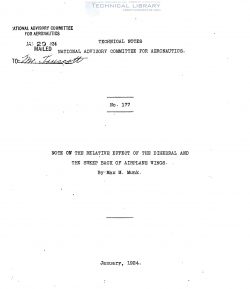naca-tn-177
- Version
- 163 Downloads
- 198.33 KB File Size
- 1 File Count
- November 4, 2016 Create Date
- November 4, 2016 Last Updated
National Advisory Committee for Aeronautics, Technical Notes - Note on the Relative Effect of the Dihedral and the Sweep Back of Airplane Wings

Dihedral and sweep back can properly be compared only to
the extent to which their action is similar in_a side slip.
In general the rolling moments due to side slip are about three
to six times greater for a given dihedral angle than for an
equal angle of sweep back.
Sweep back was used in some of the early airplanes in
order to obtain lateral stability. It is now rarely used ex—
cept in very moderate values, usually as a modification to cor—
rect a "tail—heavy” condition in an existing design. Dihedral,
on the other hand, may be found in practically all airplanes.
Since the balancing effects of these two angles are somewhat
similar their ratio for the same angle is here investigated.
Only small dihedrals and sweep backs are considered in thi§”m_
note. Both have a small influence on the wing air forces, but
it is not great and is not the subject of this note. The im—
portant effect is the unsymmetry of the air force at unsymmetrical
flying maneuvers, caused by the dihedral and the sweep back
respectively. True, even a wing without any sweep back or dihe—
dral gives an unsymmetric air force, when moved unsymmetrically
through the air. The subject of this note is the additional
unsymmetry of the air force, i-e. in a rolling moment, a yawing
moment and lateral force, caused by the sweep back-or the dihe4
dral in rolling, yawing or side slipping of the airplane.
Now, it cannot be seen how a wing Without any dihedral can
experience any considerable lateral force- On the other hand,
the lateral force plays no very important part with respect tn
the lateral stability. Hence, this difference in the action of
dihedral and sweep back, though of a fundamental nature, does
not decide the question of equivalence or non-equivalence of the
two angles.
| File | Action |
|---|---|
| naca-tn-177 Note on the Relative Effect of the Dihedral and the Sweep Back of Airplane Wings.pdf | Download |

Comment On This Post